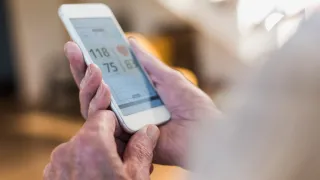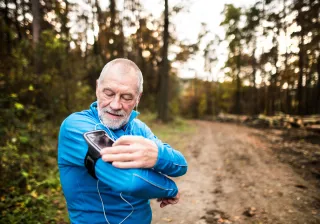The technological and digital revolution are marginalising the digitally illiterate and people suffering from the physical and cognitive consequences of ageing. On the other hand, peer support and better user interface design could help older people to make the transition to the digital age.
Imagine being 80 years old. You're trying to log in to an online bank, even if the font is so small that you need a magnifying glass and a flashlight. You can't bend your fingers properly and don't remember where you put your username and password. If you have an old mobile phone, you'll find it hard to pick out the tiny buttons, and may have forgotten which button to press in order to send a text message to your grandchild. You cannot use a smartphone, because you would forget the PIN code, and would not be able to swipe the screen or know how to download online applications. You can still answer landline calls, but operators want to get rid of the last landline connections.
– Deteriorating eyesight, impaired hearing, reduced dexterity and memory difficulties are normal effects of ageing. However, the use of modern technology requires that just these senses function well. It is terrible that unsuitable user interfaces are preventing the participation of older people, says Principal Scientist Jaana Leikas of VTT.
No wonder that so many older people become discouraged and feel left out.
People in their 60s cope, but the over 75-year-olds do not
– Of course, not all elderly people are helpless in the face of new technology. Most people in their sixties are in a different category, in this respect, to those over the age of 75. They have adopted technology at work and are a highly active group, says Leikas.
Most people in their sixties and early seventies cope well with various digital devices and applications, but most over the age of 75 do not. They may even view the use of modern technology as humiliating, because no account was taken of their situation and needs when it was designed.
– The easy accessibility of technology is an important ethical issue, since this enables elderly people to participate actively in the development of society. The experience and tacit knowledge of the elderly are capital that we cannot afford not to exploit, Leikas emphasises.
User-oriented design can support a better ageing experience
Healthy people find it hard to imagine the experiences of seniors, and too little account is taken of the needs of the elderly in the design of new technologies and digital applications.
̶ The feeling among elderly people of coping in life and the perceived self-efficacy can be supported by better user interface design, says Leikas.
The key to this is understanding their everyday lives and harnessing skills that they have learned previously.
– Human-driven development and co-creation are the ace cards. Development ideas and solutions must be tested alongside older people, in the real usage situations. Older people are highly interested in the design of their own everyday lives.
Are fingerprint and speech recognition ethical?
– The more intuitive a device's user interface, the better, because then you don't have to remember so much. For example, the development of fingerprint or face recognition is great for seniors, because these technologies do not differentiate between people. That is why they are also ethical, says Leikas, an expert in gerontechnology design and the ethics of technology.
Leikas points out that, although speech recognition is already used in new user interfaces, it should not be hyped too much because much refinement is still needed.
̶ For example, speech recognition is not safe when used in public spaces, because it is not private. Criminals are increasingly taking advantage of digital illiteracy among the elderly. In addition, the hearing of many older people has deteriorated, which may lead to changes in their speech. Speech recognition solutions must thus continually adapt, sense and learn.
A touchscreen often takes the user 'out of the frying pan into the fire', because it requires good dexterity and eye-hand coordination. For example, for a user at the early stages of Parkinson's disease, a touchscreen may not be the best solution, as it does not give as good response as when the buttons are pressed.
The digital skills of seniors can be improved through peer support
The Nettiä ikä kaikki (Internet for all ages) campaign launched by the Finnish state broadcaster Yle in August challenged all digital Finns to teach someone a useful everyday skill, such as showing an elderly friend or relative how to use email.
̶ Peer groups play a major role in the teaching of digital skills, says Leikas.
There are digisenior peer groups in big cities such as Helsinki, Tampere, Kuopio and Oulu. Helsinki has ENTER ry, an information technology association for older people, Tampere has Mukanetti ry, Northern Savonia has Savonetti ry, and Northern Karelia has Joen Severi Oy. In these associations, seniors teach other seniors how to use digital devices and applications. The guiding principle is to teach seniors on their own terms i.e. gently with an adequate amount of pauses and repetitions.
The Finnish Association for the Welfare of Older People engages in SeniorSurf teaching throughout Finland and the association 'Suomen Senioriliike – arvokkaan vanhenemisen puolesta ry' (Finland's Senior Movement for dignified aging) organises events, lectures and seminars.
Libraries for educational use
The elderly often have a high threshold for attending official events and rarely seek internet cafés, as these are not natural and familiar environments for them.
̶ But libraries are an excellent learning environment in Finland. In the Ministry of Finance's proposal for a 'digituki' (digi-support) model, it is suggested that digital skills be taught in places frequented by people, such as cafés in shopping centres or petrol stations, Leikas explains.
Finland has large numbers of retired IT support staff. Leikas believes that their skills could be useful in voluntary work.
Technology to help seniors
VTT is engaged in exploring the everyday wellbeing and health of older people, good housing, care robotics, and using unobtrusive technology to monitor people's physical and cognitive functioning. These solutions use e.g. sensor technology and IoT to monitor and identify activity levels among older people. There are high expectations of AI in the health and welfare technology sector. In the case of emerging technologies, responsible design and consideration of ethical issues such as privacy, equality and autonomy are key issues.
Leikas says that most Finns show great interest in technology that supports good ageing. However, attitudes depend on what the person in question knows about the matter. Information does not always reach citizens, and older people do not know what is on offer.
– Seniors are generally willing to accept applications that increase their safety on the basis of data gathered about them, and they have positive feelings towards research pilots. But their relatives sometimes hamper the participation in the pilots. Healthcare professionals may also question the use of technology in the homes of older people, due to the possible trouble involved in introducing new devices into home care practises, or changes in work routines.
Many people still consider robots as "humanoids", even though robotics can be found already in such everyday devices as vacuum cleaners or medicine dispensers. Older people may also find it hard to get used to, say, bath robots, that in the future could help them to bathe.
– If an elderly person is unhappy with the idea of robotics in the sauna, such a concern should be taken seriously. People's attitudes reflect their values and, luckily, values play a strong role in the adoption of technology, says Leikas, who would not welcome a robot in her own sauna anytime soon.
When Alzheimer 's disease strikes
Short-term memory, i.e. what was last learned, is lost first as a memory disorder advances.
– A great deal of technology that supports memory is already being developed. In addition to positioning devices and medicine dispensing robots, there are digital calendars that tell the user the day of the week and remind them of important issues. For example, photos of friends or relatives can be placed in the frames of table-mounted digi-calendars currently on the market. The device makes a call or video call to the person in question when their photo is pressed, states Leikas.
Leikas calls for simple, good-looking devices that do not unnecessarily stigmatise their users. Technology for older people, as any technology, must be stylish and high quality.
–However, technology for ̶ elderly people is often more than just a product – it also includes services and networks of stakeholders. The challenge is to create not only products but service ecosystems, through which several stakeholders co-operate to offer quality services and create business that is ethical and sustainable. This is Finland's competitive asset, says Leikas





